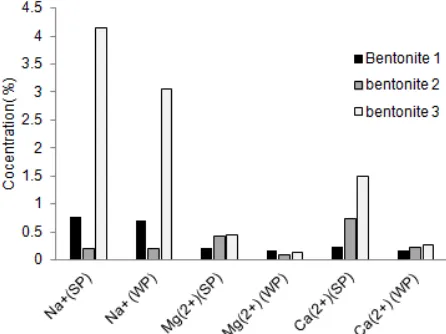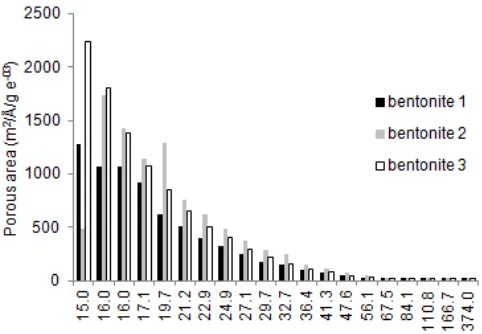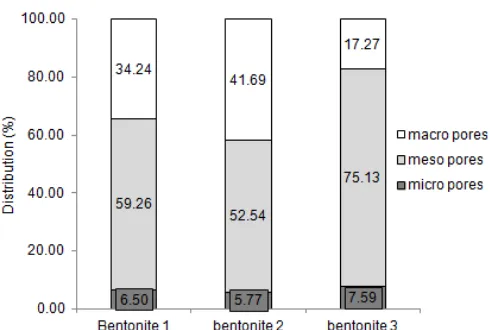Modification of Three Types of Bentonite with Zirconium Oxide Chloride (ZOC) of Local
Products Using Intercalation Process
Muzakky
*and Supriyanto C
Center for Accelerator Science and Technology-National Nuclear Energy Agency Babarsari no 21, POB 6101 YKBB, Yogyakarta 55281, Indonesia
Received September 28, 2015; Accepted December 22, 2015
ABSTRACT
Three types of bentonite modified with ZOC local products of Center for Accelerator Science and Technology-National Nuclear Energy Agency using intercalation process have been done. The purpose of this research is to create new material as a catalyst or industrial raw materials. Existance of chloride anion on the intercalation process product was releasing with water and titration using silver nitrate. The release of alkali and alkaline earth cations and Fe3+, Al3+ and Zn3+ into the water phase (WP) and the solids phase (SP) was detected by atomic absorption Spectrometry (AAS). While X-Ray Fluorescence (XRF) was to observe of Zr intercalated to bentonite layer. Modificated products were form of a porous material and their measured as micro, meso and macro pores using Surface Area Analysis (SAA) and the image of the porous material was observed by Transmission Electron Microscopy (TEM). Intercalation process products obtained were porous materials with a porous size of 1.50-1.55 nm at bentonite-3 with a pore area of 2250 (m2/Å/g) and TEM image of the 50 nm was the most transparent among the others. As for the pores size of 1.60-1.97 nm to meso pores size of 2.0-50.0 nm were dominated by bentonite 2 with a maximum of pore 1250 (m2/Å/g). While the results of the TEM image of bentonite 2, although their porous degree were small they have the pores size distribution of 5.7% micro-pore, 52.5% meso-pore and 41.7% macro-pore.
Keywords:intercalation; release; micro-pores; meso-pores; macro-pores
ABSTRAK
Telah dilakukan modifikasi tiga jenis bentonit dengan ZOC produk lokal PSTA-Batan Yogyakarta menggunakan proses interkalasi. Tujuan penelitian ini adalah untuk membuat bahan baru sebagai bahan katalis atau bahan baku industri. Keberadaan anion klorida hasil proses interkalasi dihilangkan dengan mengunakan air dan dilakukan titrasi memakai perak nitrat. Kation alkali dan alkali tanah serta Fe3+, Al3+dan Zn3+dilepas ke dalam fase air (FA) dari fase padatan (FP) dan dianalisis dengan Spektrometri serapan atom (AAS). X-Ray Flourescence (XRF) digunakan untuk mengetahui terinterkalasinya Zr ke dalam lapisan bentonit. Diharapkan hasil berupa material porous yang ukuran mikro, meso dan makro pori menggunakan Surface Area Analysis (SAA) dan citra porous bahan diamati dengan transmission electron microscopy (TEM). Hasil proses interkalasi didapat bahan porous dengan ukuran porous 1,50-1,55 nm pada bentonit 3 dengan ukuran luas pori 2250 (m2/Å/g) dan citra TEM pada 50 nm paling transparan dibandingkan yang lain. Sementara untuk ukuran pori 1,60-1,97 nm sampai ukuran meso pori 2,0-50,0 nm didominasi oleh bentonit 2 dengan maksimum ukuran luas pori 1250 (m2/Å/g). Sementara hasil citra TEM bentonit 2 walaupun derajat porousnya kecil, mempunyai distribusi ukuran mikro pori 5,7%, meso pori 52,5% dan makro pori 41,7%.
Kata Kunci:interkalasi; pelepasan; mikro pori; meso pori; makro pori
INTRODUCTION
Bentonite is a major mineral in clay and its modification products has become an important raw material in industrial usage. Some of their usage in industries such as palletizing iron ore, ceramics, adhesives, dust absorbent, emulsion stabilizers, cosmetics, paints, pharmacy, pillarization on organoclay, nanocomposite polymers, catalysts and supporting
Mg2+, Zn2+, Ca2+ Al3+, Fe3+) in the some clay minerals such as bentonite and intercalant cations such as Ti, Zr, AI and Cr [3]. The intercalation processes was easily done by mixing the dispersion of bentonite in water containing intercalant cations and by adding the polar organic such as glycerol or ethylene glycol [4]. Owing to that cation exchange process, more than 95% intercalant cations would replace in the interlayer of bentonite [1,5]. Even some anions such as chloride and nitrate would follow intercalant cations entering into the interlayer of bentonite [6-7].
Modification of natural bentonite in the form Na/Ca-bentonite has been widely carried out such as by reacting Na montmorillonite (Russia and Kazakhstan) with polyoxocation ZrOCl2 for methanol and propylene oxide catalyst [8]. Synthesis of titanium-zirconium pillared montmorillonite ([Ti, Zr]-PILC) of Na-bentonite originated from Poland river with Ti and ZrOCl2
. 8H2O (Fluka Analytical Grade) and TiCl2(Aldrich, pure > 98%) had been conducted by using the intercalation process [9]. In the same research group ([Ti, Zr]-PILC) was used as a capturing chlorinated volatile organic compounds CVOCs [10].
The new material Zr/Al-pillared montmorillonite was made by intercalation process of Na-bentonnite originated from Minghui Mining Co., Anhui China, with zirconium(IV) oxychloride (ZrOCl2 8H2O) of Aladdin Chemistry Co., Ltd, China for adsorping phosphate [11], Then Fischer-Tropsch (FT) (Zr-pillared MMT (Zr-PILC) catalysts) was prepared by intercalation processes of materials provided by Sigma-Aldrich such as Sodium montmorillonite (Na-MMT), Zirconium Oxychloride nanoparticle supported [12]. Furthermore, polymeric Fe/Zr pillared montmorillonite was synthesized through a intercalation process of calcium montmorillonite (Ca-MMT) from Nanhai, Guangdong Province, China with FeCl3 6H2O and ZrOCl2
.
8H2O from Guangzhou chemical reagent factory, Guangdong Province, China for removing Cr(VI) liquid waste [13].
instruments.
EXPERIMENTAL SECTION
Materials
At this research bentonites used was Na-montmorillonite type consisted of Na-bentonite 1 originated from Thailand, bentonite 2 from Gunung Kidul and bentonite 3 provided by Aldrich (marked by K-10, no. 281 522), ethylene glycol pa, Na, Ca, Mg, Fe, Al, and Zn standard solutions respectively were provided by Merck. As Zr intercalant cation solution, a certain amount of ZrOCl2
.
8H2O (made by PSTA-Batan) was dissolved into 100 mL of deionized water as such that the concentration of which was 0, 01M Zr and then for which 50 mL of ethylene glycol was added and stirred for 3-4 h and left it overnight.
Instrumentation
The instruments used were in this research were Atomic Absorption Spectrometry (AAS) type 50 AA-made by Agilent Australia, Surface Area Analysis (SAA), X-Ray Fluorescence (XRF) and transmission electron microscopy (TEM) and a set up of bomb digester unit.
Procedure
Intercalation
Fig 1. Intercalation Zr from local ZOC with a variety of three types of bentonite minerals
Fig 2. Released of alkaline and alkaline earth metals from solids phase(SP) into the water phase (WP) of in three types of bentonite
was then referred to water phase (WP), and the decrease of Zr concentration was analyzed using XRF with Am-241 as a source. The washing process was considered complete when the chloride ion disappeared after being titrated by using silver nitrate. Intercalant product was dried in an oven at a temperature of 110 °C for 24 h. Intercalant product was ground and its porosity degree was analyzed using SAA and TEM.
Solid Phase (SP)
Each Na-montmorillonite weight of 0.2 g, was put in the Teflon tube then added to which the mixture of 1.0 mL HNO3 and 0.2 mL HF, and then it was put in the stainless-steel tube. All of which then put in the tightly closed oven at 150 °C temperature for 4 h. Bomb digesting product was then diluted and analyzed by using AAS and it was further named as solid phase (SP).
RESULT AND DISCUSSION
The cations exchange in solid-liquid system was the most intercalation mechanism frequently occurred in the clay. The ion exchange mechanism occurs in the lining of layered double hydroxides (LDHs) to form a porous material through the intercalation process of polyoxometal [M2+1−xM3+x(OH)2](A were weakly polar so that they were easily desorpted and would simultaneously be replaced by intercalant cations such as Zr and Ti [15]. The following was zirconium intercalation processes products from local ZOC into three types of bentonite which was analyzed by using X-ray fluorescence with Am-241 as the radioactive source.
From Fig. 1, it can be shown that the intercalated zirconium at the lattice of interlayer bentonite lining obviously increased with the weight addition of bentonite and continuously at the weight of 0.1 gr. Through the absorption system was obviously that bentonite 1 < bentonite 2 < bentonite 3. This matter was in accordance with Olszewska [16] which stated that the intercalation of zirconium will be influenced by the type, the content of alkali and alkaline earth metals as well as the origin of the mineral montmorillonite area. These intercalation process was obviously not much different from the literatures [10-12], which had mixed up 0.001-0.01 g Na-bentonite, Na-montmorillonite from various regions with 0.01 to 0.1 M Zr concentration of ZrOCl2·8H2O. Furthermore, the detection of alkaline and alkaline earth metals as well as and Al3+, Fe3+ and Zn2+ metals Layered double hydroxides (LDHs) released which were replaced by Zr was an indicator of the intercalation successful [17-18]. The following were observation results of alkali and alkaline earth metals released in the water phase (WP) compared to the solids phase (SP) during the intercalation process Zr with three types of bentonite, whereas the observation was made by using the atomic absorption methods.
Fig 3. Release of Al3+, Fe3+ and Zn2+ from solids phase(SP) into the water phase (WP) in three types of bentonite
Fig 4. Release of chloride ions into the water phase (WP) in three types of bentonite
Fig 5.Distribution of pore radius by using DVR methods
bentonite [18].
From Fig. 3, it can be seen that during intercalation the release of Al3+cation of SP to WP was the highest if compared with the others. Even for bentonite 3 the
was only 40% (Fig. 1) the supporting of ethylene glycol surfactant was quite appropriate.
According to Duan [18] the intercalation process of ion exchange in the lining of inter layer LDHs of bentonite obvious of anion also participated in that process. LDHs layer as an inter layer and intra-layer which was undergoing the intercalation process could be expressed as [M2+1−xM3+x(OH)2](A
n−
)x/n·zH2O and (An−) notation was an anion. So as M2+and M3+metals as well as anions also participated in the intercalation process [19]. Furthermore, as a bentonite modification material ZOC will be dissociated in the water by releasing chloride ions as the following reaction
4[ZrOCl2.8H2O](s)+ H2O ↔ [Zr4(OH)8]+8+ 8Cl-+29 H2O Owing to the further process (pillarization) needed calcination at temperature of 600 °C and with the chloride ion which is corrosive. Therefore, the chloride ion should be removed from intercalation process product. In Fig. 4, it was shown that the chloride ion removal by washing the intercalation product using water. It was obvious that the chloride ion removal for bentonite 1, 2 and 3 were relatively constant in the 15th washing of which was 50 mL, respectively. According to Sun [19], intercalation the existence of chloride ion in the hydroxide matrix would bound intercalant cation at the ionic binding based. The removal of which using water would be very effective due to the existence of very strong hydrogen binding between the water molecules for removing the chloride ions[18].
Fig 6. Pores distribution percentages of three types of bentonite modification
Fig 7.TEM image of modified bentonite with local ZOC using process intercalation
1.50-1.55 nm (1A = 0.1 nm) turned out to be dominated by bentonite 3 with the maximum pore size area of 2250 (m2/Å/g). As for the pore size of 1.60-1.97 nm to meso pore size 2.0-50 nm dominated by bentonite 2 with the maximum area size of 1250 (m2/Å/g). While for the macro pore size > 50 nm as the area larger the pore size decreased. At this research authors agree with Cecilia [20] who had made porous clay heterostructures (WFHs) by Zr intercalation with natural montmorillonite. The synthesis products of WFHs was also porous distributed in the micro, meso and macro pores sizes.
Furthermore, in Fig. 6, the ore distribution percentages of each bentonite. At bentonite 1, proved that at bentonite 1, there existed 6.5% micro pores, 59.26% meso pores and 34.24% macro pores. At bentonite 2, the percentages of micro pores was the same as that of bentonite 1, but the percentages of meso pores was higher than that of macro pores. Furthermore, on 3 bentonite, micro-pore percentages was slightly increased to 7.59%, but the meso pores increased up to 75.13% and the remaining macro pores was 17.27%. As the percentage of meso pore had exceeded 70.0%, according to Cecilia [20] the possibility of natural montmorillonite as a modified material had been used for 1-butene isomerization.
In Fig. 7, it can be shown TEM image of the three types of bentonite at 50 nm as representative types of
porous meso pores. At the meso pores condition shown that the TEM image of bentonite 1 was more visible and slightly transparent by which illustrated more porous than that of bentonite 2. Furthermore, the bentonite 3 imaged was more transparent than others at 50 nm meso pores, thus having bentonite 3 has a higher degree porous than others.
CONCLUSION
Zirconium oxide chloride (ZrOCl2 .
8H2O) (ZOC) local products can be done to modify the properties of bentonite through the intercalation process. Intercalation process products showed that there has been an exchange of cations from the solid phase (SP) into the water phase (WP). Cation exchange occurred with the increasing concentration of Zr intercalant and the increasing cation concentration from FS into WP. Although the chloride anion of dissociated ZOC participated in the intercalation process of bentonite, but this can be overcome by removing with the aid of 750 mL of water. Intercalation generate new material with a pore size of 1.50-1.55 nm on bentonite 3 with a pore size area of 2250 (m2/Å/g) and 50 nm TEM image of the most transparent. As for the pore size of 1.60-1.97 nm up to meso pore size 2.0-50 nm dominated by bentonite 2 with a maximum size of 1250 area (m2/Å/g). While the results of the TEM image of bentonite 3 shown less porous than bentonite 1 or bentonite 2.
ACKNOWLEDGEMENT
With the completion of this paper we writer indebted to DR. Ir. Widi Setiawan who acted as head of incentive research SINAS Project entitle: Development of Processing Technology Zircon Sand Indonesia became Zirconium Products Industrial Grade, which was a collaboration research between the Ministry of Research and Technology of the Republic of Indonesia and the Nuclear Energy Agency nationwide with the contracts number of 02/SEK/INSINAS/PPK/I/2014 January 27, 2014. We would also like to thank Mr. Imam Prayogo, Mr. Bambang Irianto, and Mr. Muljono who had worked pretty hard as laboratory assistants so that this study was completed.
REFERENCES
1 Emam, E.A., 2011, ARPN J. Sci. Technol., 3 (4), 356–375.
2 Jamhour, R.M.A.Q., 2014, Can. Chem. Trans., 2 (3), 306–315.
9 Bahranowski, K., Włodarczyk, W., Wisła-Walsh, E., Gaweł, A., Matusik, J., Klimek, A., Gil, B.,
Michalik-Zym, A., Dula, R., Socha, R.P., and Serwicka, E.M., 2015, Microporous Mesoporous Mater., 202, 155– 164.
10 Michalik-Zym, A., Dula, R., Duraczyńska, D., Kryściak-Czerwenka, J., Machej, T., Socha, R.P., Włodarczyk, W., Gaweł, A., Matusik, J., Bahranowski, K., Wisła-Walsh, E., Lityńska-Dobrzyńska, L., and Serwicka, E.M., 2015, Appl. Catal., B, 174 (175), 293–307.
11 Huang, W., Chen, J., He, F., Tang, J., Li, D., Zhu, Y., and Zhang, Y., 2015,Appl. Clay Sci., 104, 252–260,
17 Mnasri, S., Hamdi, N., Frini-Srasra, N., and Srasra, E., 2014,Arabian J. Chem., 1 (2), 23–25.
18 Duan, X., Lu, J., and Evans, D.G., 2011, “Assembly chemistry of anion-intercalated layered materials”,
in Modern Inorganic Synthetic Chemistry, Elsevier B.V., 375-404
19 Sun, X., Neuperger, E., and Dey, S.K., 2015, J. Colloid Interface Sci., 459, 264–272.


